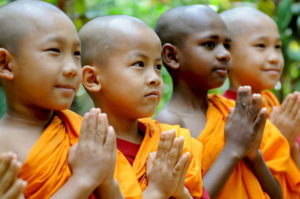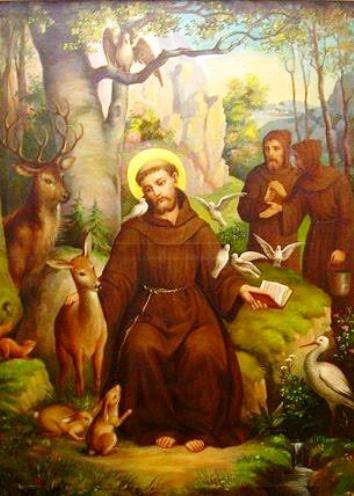The rites of Buddhism consist of mental disciplines aimed at suppressing desire.
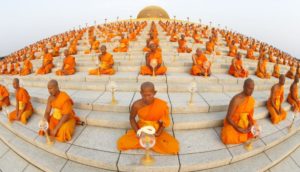
What is a ritual?
We can define it as a religious or ceremonial act based on a belief, either by a religion or an ideology.
Buddhist festivals and rituals
For Buddhism, these rituals are as if they will bring you closer to the Buddha, so that your motivation to practice will increase. There is always something joyful about these festivals.
As is the foundation of Buddhism, all celebrations focus on the Buddha, a figure who is revered by all people who profess this faith. The rituals and festivities focus on three aspects that are most important to them:
Devotion:
In this practice, when we talk about devotion, it means “surrendering to the supreme being” and has three basic aspects: commitment, transcendence and love. The first refers to being constant and focused, transcendence is based on the attitude one takes towards life, and the third aspect refers to the fact that devotion should be done with love, as it unites transcendence and devotion.
https://www.youtube.com/watch?v=UHOe3uzlII4
Contemplation:
When this aspect is handled, full mental concentration can be achieved. It is a meditative space that produces wisdom and mental strength.
Experience:
This is the most important point as general participation allows one to be part of activities, rites and celebrations.
Celebrations.
- Kannon Day (January): Buddhist New Year. It is celebrated with prostrations, chanting and offerings and incense to honour and thank the Bodhisattva of Compassion.
- Buddha Paranirvana (around 13 February): commemorates the Buddha’s sermon, a full day of zazen (celebration of the Buddha’s ascent), concluding with a special service of chanting recounting the Buddha’s paranirvana.
- Sakiyamuni -Vesak (between April and May): celebration of the Buddha’s birth, exhibition of a baby Buddha, offering of sweet tea, flowers and small gifts for babies, stories or plays about the Buddha’s birth, piñats and gifts for all children.
- Phagunna: celebration of the origin of life.
- Bodiharma Day (around 5 October): celebrated with special chanting and offering of incense powder.
- Oxfan Fasting Day (twice a year): A fasting ceremony whose money and food is donated to hunger relief organisations.
Buddhist festivals.
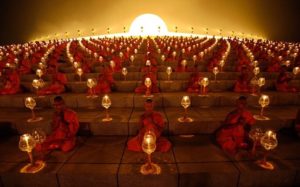
THE MAGHA PUJA (Tuesday 19 February. Thailand.
Held in February, this festival commemorates the sermon given by the Buddha to 1250 monks, which laid the foundations of Buddhism. It takes place in countries such as Thailand, Laos and Cambodia. Most monks belong to the Theravada, or Southern, school of Buddhism. They celebrate this festival with prayers, meditations, 3 rounds around the central altars with candles, incense and flowers under the full moon.
PII MAI (3 days in April) Laos.
It is the celebration of the new lunar year, the official calendar celebrates 3 days of festivities, although in other countries this celebration lasts a week. The first day of the festival coincides with the last day of the ending year, a time of renewal. The second day is a spirit of transition between the year that has just ended and the year that is about to begin. The last day of the festival refers to the first day of the year for them.
It is celebrated in the month of April, and it will depend on the date according to the lunar calendar. This festival always starts in the middle of the month and all the villagers are invited to participate and celebrate. In this festival the main symbol is water, houses are cleaned, people wear new clothes and Buddha images are washed with water.
PARINIBANNA (15th day of the lunar month). China
On this festival, the main celebration is the birth of Buddha. To celebrate this, an offering is made with many lamps. A table is set up with them and the attendants light the lamps, symbolising the worship of love, patience and control of the mind, as well as other virtues. This feast ends with a candlelight celebration.
KAO PHANSA. (28 July – 24 October). Pali.
It is also known as the ‘Festival of Lights’. Celebrated immediately after the end of the Ashala Puja, this festival marks the beginning of the confinement of Buddhist monks in Buddhist temples for a period of 3 months to devote themselves to study and meditation. It is the time chosen by many families to send young people who wish to enter the monasteries. It is also a tradition to carry carved candles several metres long in processions through the city, an event of great importance as it coincides with the beginning of the end of the rainy season.
EWK PHANSSA. (October)
This is a very important festival for Buddhist monks, as it gives them permission to leave their monasteries and travel around the countryside.
THAT LUANG (November – full moon). Laos.
This festival is celebrated in the month of November with the arrival of the full moon, when monks leave their monasteries to receive offerings and flowers.
At the beginning of the first day, the people arrive in their best clothes with bowls full of offerings and take their positions on mats on the ground. At the appropriate moment, the offering begins to the hundreds or thousands of monks, nuns and novices who come to the capital from all over the world. They then return to their monasteries carrying large sacks of offerings in a colourful procession through the village, ending with a candlelight feast.
VESAK (9 May). Asia.
Another important festival in Buddhism, the most important for millions of Buddhists around the world, it celebrates the birth, death and enlightenment of the Buddha. Of all the holidays, it is the holiest. For Buddhists all over the world it is
For Buddhists around the world, it is a day of perfect happiness, an opportunity to celebrate their message of sharing, devotion and service to humanity. To celebrate Vesak, Buddhists go to temples and make offerings, and houses and streets are lit with paper lanterns.
DHAMMA DAY (27 July). Thailand
This day celebrates the Buddha’s first sermon (Dhammacakkappavattana Sutta or “The Discourse on Setting the Wheel of Dhamma in Motion”).
Cults of Buddhism.
Buddhism is usually defined as a philosophy rather than a religion.
Buddhist initiation
is used to awaken one’s inner potential for Buddhahood. When a child turns 8 years old and wishes to be initiated into Buddhism, he or she is taken to the monastery, the date being set according to the child’s horoscope so that it is the most favourable for the child. When he enters the monastery he is welcomed by the monks and the children are given the three jewels of Buddhism, which are
- to acknowledge the Buddha as their teacher
- to follow his teachings
- Become part of the Buddhist community

He is then stripped of his clothes and given the yellow sacred robe, his head is shaved and he is given the items that a Buddhist monk must use: a belt, a needle, a razor, a filter, a fan and a begging bowl. He is also read the 5 basic rules of Buddhist morality, which he must follow throughout his life:
- Do not destroy life
- Do not steal
- Refrain from misconduct
- Not to speak falsely
- Not to take mind-altering substances.
The second stage is known as Upasampada. Here the young man is regarded as a Buddhist monk. So when he is older he will be taught the 10 precepts that the monk must respect, he will be given teachings to learn wisdom, compassion and finally he will discover that nothing is to be believed unless one is convinced.
At the age of 20, the ritual is celebrated as the young man is now a full monk.
-
Death ritual
For Buddhists, death is not seen as something painful or bad, on the contrary, it is a step for the soul to reach Nirvana, which is why the ideal death is one in which the person is conscious of what is about to happen. Death is the beginning of a new life.
The Buddhist death or funeral ritual begins with what is known as the “rite of passage”, which consists of reading the Book of the Dead to the person who is about to die or who has already died. It is said that this type of reading is done with the intention of providing the deceased with the knowledge and keys that will be useful in the intermediate state. The funeral lasts 49 days, during which the relatives offer food and drink to the spirit of the deceased.
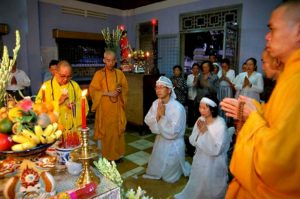
After 49 days of burial, the funeral rites begin when a monk sets the date for the ceremony called “Gnan Sop”; during this time, the body is prepared with formaldehyde so that it can be kept at home for 7 days before cremation or burial as requested by the family. It is also customary to leave the body in its natural state of decomposition. It is also customary to place candles and a photograph of the deceased on the pyre, and the attendants wear black clothes or white shirts.
At the end of this cycle, the prayers to Buddha begin as part of the ceremony to evoke the spirit, the monks sing chants in the most traditional funerals while the rites are performed, from among those present is chosen the person responsible for a special tribute to the deceased, who will read some prayers, depending on the sex must observe certain rites, If it is a man, he is called “monk”, he has to shave his head and wear the traditional dress, and if it is a woman, she is called “white mother”, she is dressed in white and she does not touch any man to preserve her pure state, she stands behind the coffin and holds in her hand a white thread that symbolises the path that the deceased spirit must follow.
A week after the funeral, a ceremony is held to honour the deceased, and after 49 days, a final farewell ceremony is held. Another ceremony is held after one year, and a final farewell ceremony is held on the third anniversary.
A week after the burial, a ceremony is held in honour of the deceased, and after 49 days, a final farewell ceremony is held. After one year another ceremony is held, and on the third anniversary the mourning period ends (see article: Buddhism and Christianity).
Rites of Buddhism.
A large number of rites and festivals enrich this wonderful religion, some of which are as common as in other religions.
-
New Year rites
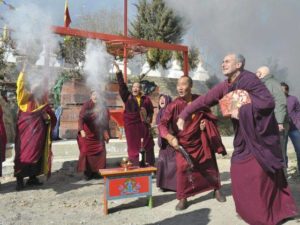
Songkran is one of the most important New Year’s celebrations and is the equivalent of our Christmas. Songkran marks the turning of the Sun in Pisces Aries, the date is calculated according to the solar calendar, but is celebrated on fixed days from 13 to 15 April. In some countries it is celebrated on 6 February, in Tibet on 18 February.
These celebrations preserve traditional values and have a family character, with each family performing various rituals, visiting temples to make offerings and taking part in religious ceremonies. One of the most famous and well-known rituals of this festival is the celebration in the streets, where people throw water and coloured powder at each other, symbols of purification and the cleansing of sins.
Another rite consists of taking the images of Buddha out of the monasteries and carrying them in procession among the people to sprinkle them with water. On the other hand, the “Losar” is celebrated and lasts for more than 15 days, of which the first three days are the most important and significant; its rituals:
- On the first day, it is customary to make a drink called “Changkol”, which is made from a type of Tibetan beer.
- The second day is known as “Gyalpo Losar” (King Losar), this day is reserved for a meeting in the Hall of Excellence of Samsara and Nirvana.
- On the third day, people and monks begin to celebrate and enjoy the festivities of the season.
Ritual for prosperity.
The Golden Buddha, This rite consists of placing a golden Buddha in the house and making offerings of rice, fruit and coins in the belief that this will attract the energy of abundance.
Religious rites.
Buddhism has a series of rituals, which are the pujas and initiations, there are also ceremonies that bring an air of mystery that are special in this spiritual path, such as
Ritual of Chod: this ritual is based on esoteric rituals, in ancient times it was a very secret ritual. Chod means to cut, to become a Chod master the main test is to do several meditations in 100 cemeteries, its celebration consists of chanting prayers to the beat of drums with a very identifiable rhythm, the most striking thing about this rite is that the monks wear black masks at the beginning of the ceremony, according to their tradition this is to avoid being disturbed by evil spirits.
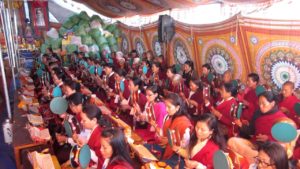
Heart Sutra Puja: is a celebration where offerings are made to the Buddha to receive his blessings. This ritual lasts about an hour, with loud drumming, prayers and sacred music. It is a ritual in which the mantra of the Heart Sutra is recited: GATE GATE PARAGATE, PARASAMGATE, SOHAN, which means: “Beyond, beyond, beyond, always beyond.
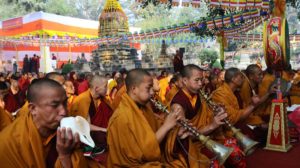
The purpose of this ceremony is to eliminate the demons that the Buddha defeated while meditating under the tree.
Purification with Yamantaka: is a ritual of purification or energetic cleansing in which the monks cleanse themselves with the four elements: water, air, earth and fire. Many people have benefited from this practice, which helps to get out of depressive and unhealthy states.
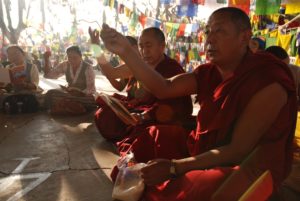
Yamantaka is the Buddha Conqueror of Death, believed to have the power to remove that which causes harm.
Mo or Spiritual Consultation of Divination with Dice:
This is one of the most striking divination rituals, consisting of asking a series of questions of the master, who invokes his tutelary deity and throws the dice which, according to his interpretation, will give the exact answer.
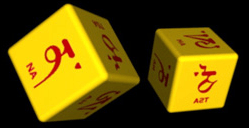
It is a special, very spiritual counselling that very few teachers do.
Baptisms.
Performed with the intention of purifying the mind, this is a ceremony performed as an entry into the practice of the esoteric secret; one is baptised, and each time one enters a new stage, one must be baptised again. The rite varies according to the master conducting the ritual, but the most common is for the master to contemplate a mandala with a bottle in his hand, imagine four dragons vomiting water into the bottle, and pour the water from the bottle on the apprentice’s head. In this way he will gain Buddhist power and have a purified mind.
Prayer mills.
It is one of the most important objects in Tibet, regardless of its size, it is of great value to the Tibetan people. It is usually found in monasteries. It is used as an element to spread prayer into the world and cleanse it of both suffering and negativity.

Everyone starts with the mantras, in this case OM MANI PADME HUM, which means ‘Oh, Jewel in the Lotus’. With this mantra we achieve communion with the divinity of Avalokitesvara’s compassion. Reciting this mantra is done for the benefit of other living beings.
Prostration on the ground.
This is one of the most pious rituals that the most devout monks can perform to honour the Buddha.
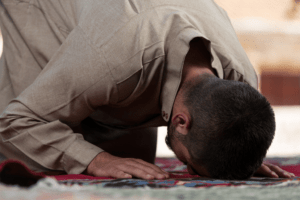
The bow can be done in two ways:
- The devotee stops, recites the universal mantra (om mani padme hum), brings the hands together in front of the chest, raises them above the head, takes one step forward, brings the hands to the chest, on the third step separates the hands and bows the chest to the ground, kneels down and then stretches out the whole body and touches the ground with the forehead.
- Another way of performing this bow is to touch the ground with the whole body, which is only customary in monasteries or sacred places, and the worshipper makes the same greetings as if he were kneeling, except that in this case the body goes all the way to the ground. It is done in order to fulfil some obligation or to pray for protection, happiness or the removal of some suffering.
Encierro.
This is an act in which all contact with the outside world is avoided and mantras are recited according to some traditional rites. The confinement can last from a few days to several years, and the practitioner is not allowed to leave for any reason before the end of the confinement.
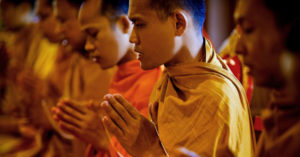
The aim of this activity is for the student to have an experience that allows him/her to cultivate him/herself in order to attain the fruit of understanding Buddhism.
Religious dances.
At the end of the year, religious dances are performed in the monasteries.
On this day the monks put on masks and some dress up as yak, sheep and deer deities and parade around the monastery to drive out the monsters and evil spirits of the previous year and welcome in the New Year.
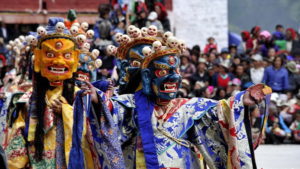
Customs.
Its ideology includes many festivities and rituals; depending on the Buddhism one is talking about, the customs and practices vary, which is why it is difficult to mention them all, but there are two customs that are the most important and the most used. The first is meditation, which is considered to be the Buddhist practice par excellence and refers to the cultivation of the mind. It increases understanding and wisdom, and we can quote its technique according to the main schools of Buddhism:
- Theravadha Buddhism: emphasises the progressive path of practice, which refines the practitioner’s realisations.
- Zen Buddhism: emphasises the spontaneous and intuitive nature of wisdom, avoiding dualism in the understanding of reality.
- Tibetan Buddhism: emphasises the symbolism of the mind and is a ritualistic practice that seeks to transform the mind through a progressive path.
The second practice of Buddhism is worship, which takes place both at personal altars and in temples or monasteries, and consists of worshipping the Buddha through mantra and prayer. There are also followers who worship by making offerings and gifts (see article: Buddhism as Philosophy).
Beliefs of Buddhism.
As we know, Buddhism centres its beliefs on the Buddha, who through his efforts transformed himself and achieved enlightenment.
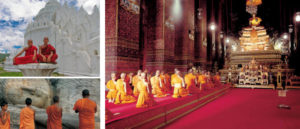
There is no concept of a creator god in Buddhism, so its beliefs are centred on what the Buddha considered to be his four noble truths:
- The truth of pain (Duhkta): Pain is universal.
- The truth of the origin of pain (samudaya): the cause of pain is the desire to live again and to seek what one loves.
- The Truth of the End of Pain (Nirodhaes): It is possible to end frustration and pain through a process of action, understanding and meditation.
- The Truth of the Path (Magga or Noble Eightfold Path): Desires are overcome and suffering is ended. Suggests 8 ways to Nirvana.
Main beliefs.
- God: Does not talk about who he is, although in Mayama Buddhism the Buddha is worshipped as a god.Transmissions: At no time in history has there been a book that collects the stories of this religion.
- Myths and stories: the most representative are those that tell us about the life of the Buddha, his stories that collect his words.
- Rites and festivals: the main festival is in the month of May, commemorating the birth, enlightenment and entry into Nirvana.
- Sacred lugres: in Nepal Lubini, the birth of Buddha. Bodghaya in India, Buddha’s enlightenment. Samath India the first sermon. Kusinagara in India, Buddha’s death.
Buddhism Step
8 steps to follow the path:
- Right view: This is to accept the four noble truths.
- Right determination: to renounce all desires and all thoughts that resemble lust, bitterness and cruelty.
- Right speech: to speak only the truth, there can be no lies.
- Right conduct: to abstain from sexual immorality, stealing and killing.
- Right occupation: To work in an occupation that benefits others and harms no one.
- Right Effort: To eliminate all evil qualities from within and to prevent new ones from arising. One should seek good and moral qualities and develop those that one already possesses.
- One must strive to grow in maturity and perfection until universal love is attained.
- Right contemplation: to be attentive, complete. One must be free from desire and suffering.
- Right Meditation: By being free from desire and evil, it is believed that one can, through one’s own efforts, attain a state of eternal peace and bliss which we know as Nirvana (see article: Buddhist Culture).

